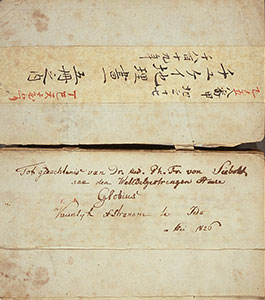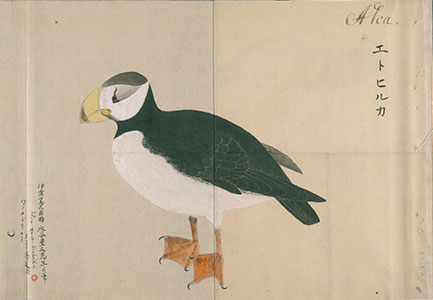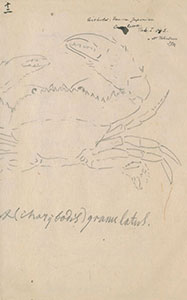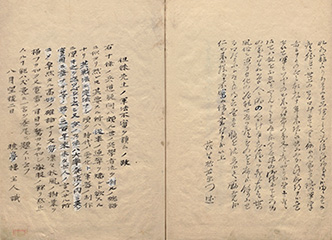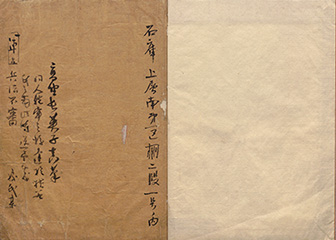Chapter 3 Eyes of science People around Siebold
People around Siebold
Philipp Franz Balthasar von Siebold, 1796-1866
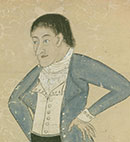 A German doctor, who came to Japan in 1823 as a medical officer serving the Dutch trading house. He taught Western medicine and natural history to many students at Narutakijuku in Nagasaki. On the journey from Nagasaki to the Edo court (from February 15 to July 7 of 1826), Siebold established relations with many scholars of Dutch studies on his way to Edo and exchanged information. The fruits of his interactions can be seen in his major publications titled Nippon, Flora Japonica, and Fauna Japonica. He was expelled from Japan in 1828 for attempting to smuggle maps and other prohibited goods outside of the nation (Von Siebold Incident
A German doctor, who came to Japan in 1823 as a medical officer serving the Dutch trading house. He taught Western medicine and natural history to many students at Narutakijuku in Nagasaki. On the journey from Nagasaki to the Edo court (from February 15 to July 7 of 1826), Siebold established relations with many scholars of Dutch studies on his way to Edo and exchanged information. The fruits of his interactions can be seen in his major publications titled Nippon, Flora Japonica, and Fauna Japonica. He was expelled from Japan in 1828 for attempting to smuggle maps and other prohibited goods outside of the nation (Von Siebold Incident![]() ), but returned again in 1859.
), but returned again in 1859.
33 James Hingston Tuckey, Aardrijkskunde voor zeevaart en koophandel, Rotterdam: J. Immerzeel, 1819[蘭-269]
This article is the Dutch version of the first print of Maritime Geography and Statistics written by James Hingston Tuckey, who was a commander of the British Royal Navy and an explorer. It was a gift from Siebold to Takahashi Kageyasu, who was Temmonkata (an officer at the Bureau of Astronomy). On the reverse of the front page, Siebold has written a note of dedication in Dutch, which reads, “To Dearest Globius at the Astronomical Observatory of the Edo Kingdom, as a gift from Philipp Franz Balthasar von Siebold, Doctor of Medicine. May 1826”. “Globius” was a Dutch name given to Kageyasu. He had a close relationship with Siebold and worked to gain information on international affairs, but was held responsible for the Von Siebold Incident and died in prison. This book was confiscated by the Shogunate. It was an old possession of the Bansho Shirabesho (Institute for the Study of Western Books).
MIZUTANI Toyobumi, 1779-1833
 A feudal retainaer of the Owari Domain and a natural historian, who was in charge of maintaining the domain’s medicinal-herb garden. Also known as Sukeroku. Studying the traditional pharmacognosy from Ono Ranzan and others, and learning Dutch studies from Nomura Ryuei (the first), Mizutani eventually became the teacher who fostered members of Shohakusha (the association of natural historians in Owari), such as Ito Keisuke and Okubo Masaaki. Mizutani also interacted with Philipp Franz Balthasar von Siebold, who was on his journey to the Edo court. Mizutani was introduced as “the renowned botanist of Japan, named Mizutani Sukeroku” in Siebold’s work titled Flora Japonica, in which his representative work titled Buppin shikimei (lit. A Catalogue of the Names of Things)
A feudal retainaer of the Owari Domain and a natural historian, who was in charge of maintaining the domain’s medicinal-herb garden. Also known as Sukeroku. Studying the traditional pharmacognosy from Ono Ranzan and others, and learning Dutch studies from Nomura Ryuei (the first), Mizutani eventually became the teacher who fostered members of Shohakusha (the association of natural historians in Owari), such as Ito Keisuke and Okubo Masaaki. Mizutani also interacted with Philipp Franz Balthasar von Siebold, who was on his journey to the Edo court. Mizutani was introduced as “the renowned botanist of Japan, named Mizutani Sukeroku” in Siebold’s work titled Flora Japonica, in which his representative work titled Buppin shikimei (lit. A Catalogue of the Names of Things) ![]() was also cited. Mizutani’s illustrated catalog of plants amazed Siebold for having all the specimens included accurately identified with scientific names defined by Carl von Linné. A copy of the book still exists in the Netherlands.
was also cited. Mizutani’s illustrated catalog of plants amazed Siebold for having all the specimens included accurately identified with scientific names defined by Carl von Linné. A copy of the book still exists in the Netherlands.
34 Etohiruka-zu (from Kinka kinfu, vol. 4), [ca. 1804-1818][寄別11-10]
A compilation of avian-related materials and manuscripts, which were collected by Ito Keisuke and organized by his apprentice natural historian named Tanaka Yoshio and grandson Ito Tokutaro. It contains Keisuke’s handwritten manuscripts and pictures along with many literary works authored by people in Owari and the surrounding area. The inserted part is the illustration made by Mizutani Toyobumi. Though it is titled Etohiruka (tufted puffin) it actually depicts a horned puffin. The scientific name in Latin “Alca” is written on the upper right corner. Shikigo (a record of the origin of transcription/acquisition as well as dates, which is usually attached to the front or back of the main text of manuscripts and/or printed books) written by Tokutaro states that it may be “the handwritten judgment by Siebold”. Mizutani’s own work titled Mizutani kimpu![]() also contains an article on Etohiruka. An illustration similar to this sample accompanied the description, which records that the bird was captured offshore of Atsuta (present Nagoya City, Aichi Prefecture) in April 1809.
also contains an article on Etohiruka. An illustration similar to this sample accompanied the description, which records that the bird was captured offshore of Atsuta (present Nagoya City, Aichi Prefecture) in April 1809.
ITO Keisuke, 1803-1901
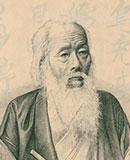 A natural historian and a doctor. He also wrote under the name “Kinka”. Keisuke studied under Philipp Franz Balthasar von Siebold together with Mizutani Toyobumi. He published Taisei honzo meiso
A natural historian and a doctor. He also wrote under the name “Kinka”. Keisuke studied under Philipp Franz Balthasar von Siebold together with Mizutani Toyobumi. He published Taisei honzo meiso![]() , which was the first book to introduce the modern botanical classification method of Carl von Linné to Japan. Keisuke acted as central figure of Shohyakusha, which was the association for natural historians in Owari. He also took charge in research and education as the president of Owari-han Yogakusho (School of Western Learning of the Owari Domain). After the Meiji Restoration, Keisuke moved to Tokyo and continued his study in Koishikawa Botanical Garden as a professor of the University of Tokyo, eventually becoming the first Doctor of Science in Japan. He lived to be ninety-nine years old, and the vast amount of natural history materials he collected throughout his life were inherited by his botanist grandson, Ito Tokutaro; the majority of it exists as the Ito Collection
, which was the first book to introduce the modern botanical classification method of Carl von Linné to Japan. Keisuke acted as central figure of Shohyakusha, which was the association for natural historians in Owari. He also took charge in research and education as the president of Owari-han Yogakusho (School of Western Learning of the Owari Domain). After the Meiji Restoration, Keisuke moved to Tokyo and continued his study in Koishikawa Botanical Garden as a professor of the University of Tokyo, eventually becoming the first Doctor of Science in Japan. He lived to be ninety-nine years old, and the vast amount of natural history materials he collected throughout his life were inherited by his botanist grandson, Ito Tokutaro; the majority of it exists as the Ito Collection![]() (approximately 2,000 books) in the National Diet Library.
(approximately 2,000 books) in the National Diet Library.
35 Kinka kaifu, (vol.2), [transcribed in the end of the Edo period][寄別11-7] 
The title on the cover page reads Shishi kaifusho. “Shishi” refers to Siebold. A volume from Kinka kaifu (manuscript. Total of five books), which is the compilation of various materials and manuscripts on crabs collected by Keisuke and edited by his grandson Tokutaro. It is an abstract of the Crustacea part of Fauna japonica (see Related material 35) edited by Siebold, and contains the comparative list of scientific names and Japanese names and illustrations that appear in a commentary written by Siebold. According to shikigo (a record of the origin of transcription/acquisition as well as dates, which is usually attached to the front or back of the main text of manuscripts and/or printed books) written by Tokutaro, Keisuke had researched and summarized the book and copied illustrations by carefully tracing them in pencil at the end of the Edo period.
There is also a note written by Keisuke, which reads, “too many illustrations - was able to copy only a part of them”. Though Keisuke is renowned for his achievements as a botanist, he was widely interested in all natural objects.
35 Related material:Ph. Fr. de Siebold; elaborante W. De Haan, Fauna japonica. Crustacea, Lugduni-Batavorum: Ex Officin. Lithogr. Auctoris et Typis J. G. La Lau. 1850.[Sd-101]
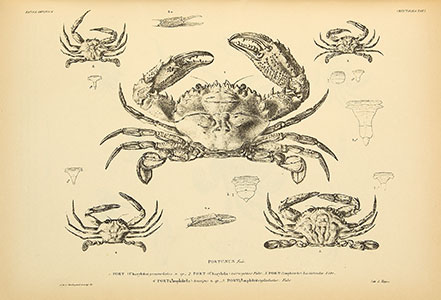
The birth of the pencil
1The pencil was invented in the United Kingdom sometime during the 16th century as a writing tool in which a stick of graphite which was discovered then by chance, is encased in wood. The pencil was introduced to Japan via the Netherlands and during the Edo period, when the isolation policy was in effect, was considered quite valuable as an imported good. Materials 35 (Ito Keisuke) was written with a pencil from this era.
The first pencils made in Japan were displayed at the National Industrial Exhibition in the early Meiji era. After the successful development of a method for mass production, the use of pencils was adopted by government officials, and they were gradually accepted by the general public.
The first use of pencils for education took place in elementary school art classes. They later came to replace the writing brush as a standard writing tool during the 1910s and 1920s.
TAKANO Choei 1804-1850
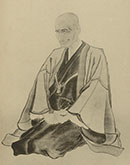 A Dutch scholar and a doctor. Born in the Mizusawa area of Isawa County, Oshu, Choei was raised by an adoptive father Gensai, who was a pupil of Sugita Gempaku. Choei studied Dutch in Philipp Franz Balthasar von Siebold’s Narutakijuku. A monograph Choei had written in Dutch was later included in Siebold’s work titled Nippon. Choei was imprisoned during bansha no goku (Imprisonment of the Companions of Western Studies, 1839) for the crime of criticizing the Shogunate, but he broke out of prison and escaped. He was eventually smuggled back into Edo via Uwajima and Hiroshima. He ended up killing himself when the government officials stormed to capture him in 1850.
A Dutch scholar and a doctor. Born in the Mizusawa area of Isawa County, Oshu, Choei was raised by an adoptive father Gensai, who was a pupil of Sugita Gempaku. Choei studied Dutch in Philipp Franz Balthasar von Siebold’s Narutakijuku. A monograph Choei had written in Dutch was later included in Siebold’s work titled Nippon. Choei was imprisoned during bansha no goku (Imprisonment of the Companions of Western Studies, 1839) for the crime of criticizing the Shogunate, but he broke out of prison and escaped. He was eventually smuggled back into Edo via Uwajima and Hiroshima. He ended up killing himself when the government officials stormed to capture him in 1850.
36 OGYU Sorai, Gumpo fushin, transcribed by TAKANO Choei, [late Edo period][Katsu Kaishu Papers: 53]
A hand-copy made by Choei (age 47), which was given to 28 year-old Katsu Kaishu, who was running a private Dutch studies school, on parting after they had a midnight discussion around September 1859, which was when Choei was hiding in Edo after his jailbreak. Gumpo fushin is an alias for a military science book by Ogyu Sorai, titled Kenroku gaisho. There was no woodblock printed copy in existence, and only hand-copies and mokukatsuji-bon (wooden movable type imprints) were in circulation. In the afterword at the end of the book, Choei had written that he was “so impressed that I felt the urge to” make the transcription, indicating the amazement he felt after reading the text. Choei died a month after this encounter. It was previously owned by Katsu Kaishu.
Old-fashioned whiteout
The modern form of whiteout was invented in the US by a typist in 1951. It has been produced in Japan since 1970 and has been improved for easier use with ordinary stationery as well as with typewritten documents.
Something similar was used in Japan long before whiteout was invented. There are some historical manuscripts by Udagawa Genzui, Takano Choei, and others, in which characters were corrected using a white liquid made with pigment from powdered shell, gofun. There are, however, very few examples of this material being used for writing letters.



